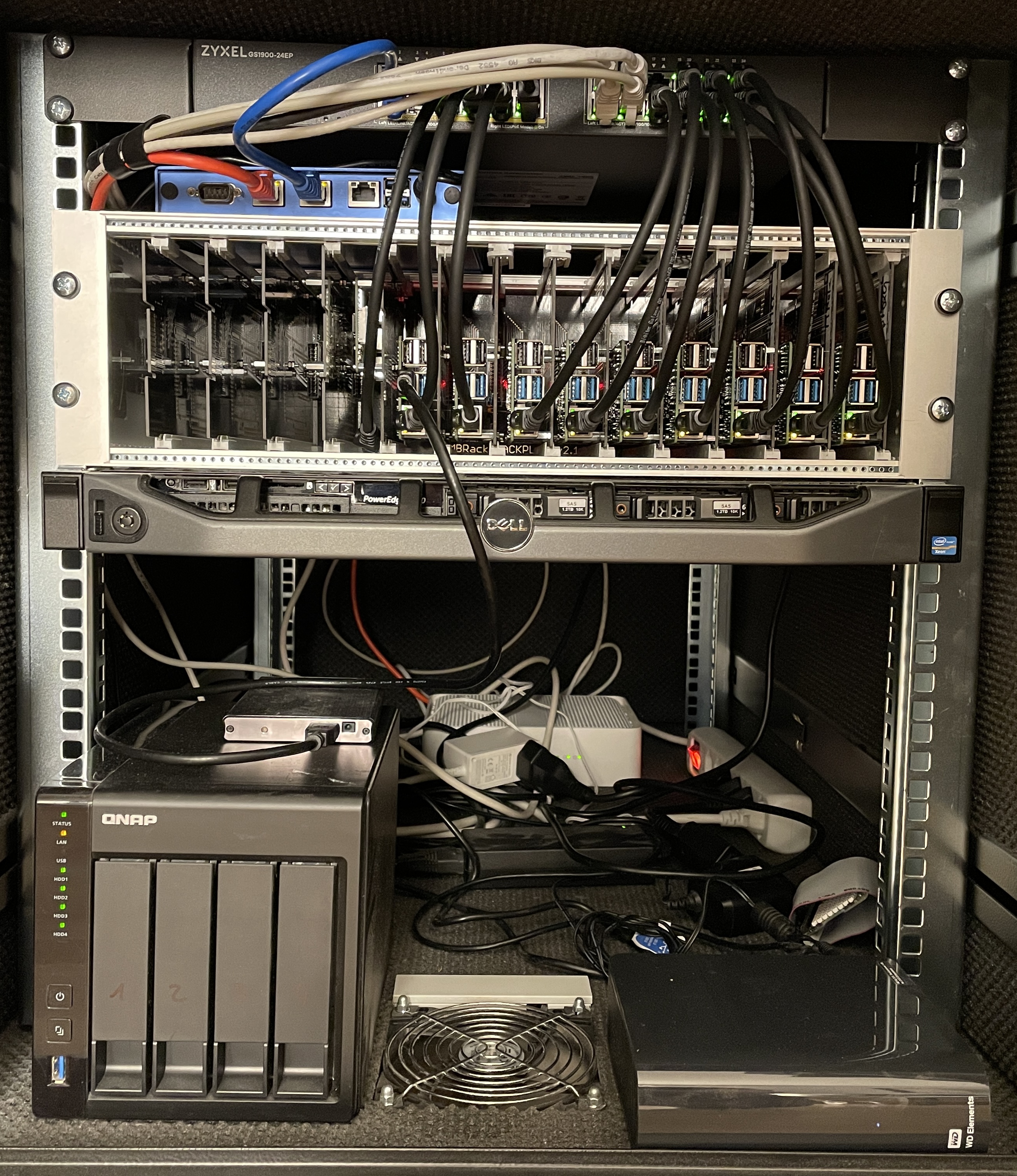Migrating from x86 to ARM (Raspberry Pi)
I’ve run my services on used Dell and HP servers for a few years now. I’ve decided a few months ago that I want to replace my x86 Dell server with a bunch of Raspberry Pis.
Reasoning
Noise
I live in a small apartment and the server is stationed in my living room. For a long time I had the server hidden under my couch. This worked but the noise was quite notable. A few years ago I bought a rack which is specifically designed to block noise which helped quite a bit. However it still produced some noise because of the three fans in its walls. In addition I thought that it might still leak some sound from the server fans but this turned out to be not true. The volume stayed the same after I powered of the server.
So I hoped that I would be able to power off the fans once I switched to passively cooled Raspberry Pis. As it turned out this isn’t possible. The heat inside the rack gets too much without the fans running. The firewall got up to over 70 degrees Celsius. It might work out but it’s better for the longevity of the devices and the performance to keep the fans running. The Raspis are far less likely to throttle when properly cooled. Luckily they are not that loud and not as high pitched as the server fans.
Heat and power consumption
The heat is the more pressing of the two issues. Especially during the summer it gets quite warm in my flat, which is under the roof. Adding a server to it really doesn’t help to cool it down.
The temperature in my flat is usually around 23 – 24 degrees. With the Raspberry Pis it’s now around 21 – 22 degrees. So already quite a bit lower and I can really feel the difference in air temperature coming out of the rack. We will see how well it works during the hot days. After all the devices inside the rack are still producing some heat.
As for the power consumption, I never really measured the Dell server. However it was a dual socket system so easily around 100 W. In an initial test a Pi used between 3 – 4 Watts of power while idling and a bit under 8 Watts under full load. This was before I disabled Bluetooth and WiFi on all of them so they should consume now around 2 – 3 Watts in idle1 .
Repairs and transparent costs.
I know you can get used servers fairly cheap or even for free (the Dell machine is such a server). However if you really want to be on the safe side you should have two. The second one being for spare parts in case something breaks. Otherwise you have to be lucky to find the replacement parts when you need them.
Granted, with the current situation you have basically the same problem with the Pis since they are so hard to get. But if you can get them it’s much easier to keep a spare Raspberry Pi around than a whole server.
With my current setup one Pi is running one service. This means that if I want to add a new service it’s going to cost me about one Raspberry Pi. Which makes it much easier for me to decide if it’s worth it or what a replacement might cost me.
Learning
Obviously the setup with the x86 server was much more flexible. I used Proxmox as the hypervisor so I just could spin up a new VM, test something and if I didn’t need it, I could just destroy it again. The backup and snapshot functionally are very helpful as well.
The Raspberry Pi setup doesn’t have this luxury but it forces me to try new things and solve the various problems. After all I’m doing this not just to improve my privacy but to learn something new as well. I’m especially looking forward to do all this with NixOS since it has various ways how you can quickly test something without having to install it permanently.
The setup
Hardware
I got a very nice rack mount from a friend. It has fourteen slots from which I’m currently using ten. One holding the spare Pi. The rack mount is open source, the source can be found in the foot note2.

Software
For the OS I chose NixOS because it is currently the distribution that I like using the most. In addition it uses very little resources. This way I don’t waste any resources on something I don’t really need.
Currently I’m hosting the following services:
- Nextcloud
- TT-RSS + RSS Bridge
- Docker-Mailserver
- Grav (this blog)
- Gitea
- Plex
- PiHole
- Heimdall
Docker and Host Services

All of these services are running in a Docker container. I might switch some of
them back to native applications but currently I don’t want to mess around with
applications and their dependencies. What I did however is migrate away from
docker-compose and use the NixOS virtualisation.oci-containers option to
define the containers. A lot of it is very similar to docker-compose but it
is missing a few features. For example, the automatic network configuration is
missing. To solve this I had to write a system.activationScript to create the
network at boot if it was missing3.
In addition I stopped using DBs in containers and migrated back to using the OS
packages. It’s IMO just easier to administrate and backup them this way. For
all of my DBs I implement a backup solution with Restic. A systemd service
triggered by a timer dumps the DB data into Restic via stdin and alerts me
via Telegram if something went wrong 4.
The option --add-host=host.docker.internal:host-gateway is very important if
you want to access your database running on the host from a container. With this
option your database is reachable under “host.docker.internal” from within the
container. So you don’t have to use the IP which might change.
Since it’s very easy to use Nginx with Let’s Encrpyt, I stopped using Traefik for this task5. Some applications are even using Nginx to forward requests to PHP-FPM running inside the container6.
Long story short, I only use containers for the application itself. Everything else is running on the host configured through Nix. This way I don’t have to care too much about the application setup and can update as many packages as possible through the system package manager.
Raspberry Pi specific changes
Since my Raspberry Pis are running on SD cards (64GB SanDisk High Endurance Monitoring) I decided to implement some changes in order to hopefully increase the lifespan of the SD cards a bit.
I mount /var/log to a tmpfs meaning a RAM disk. This way logs don’t get
written to the SD cards but stay in RAM. With the Raspberry Pi 4s RAM isn’t
that much of a problem anymore so this is an easy solution. In addition I
enable volatile logs in systemd. As I understood it, this is basically the
same but for all the logs which get stored in the systemd journal7. The
drawback is that the logs are lost when you restart the Pi. To help with this I
send all the logs to my NAS which acts as a syslog server. This has the
additional advantage that in case someone fucks with my servers and deletes the
logs, they are stored on a different device as well8. By the way lnav is a
great way to look through the logs on the NAS9.
Another change that I implement is to store as much data as possible on my NAS
and access it through NFS. Docker can mount NFS shares directly but it is a bit
of a pain to write the option for it. This works much better with
docker-compose10. I don’t store any database data on the NFS share because
this might lead to corruption. At some point I might play around with ISCI but
with my current setup this involves a lot of manual steps which I don’t want to
do. The data from TT-RSS gets stored on the SD card as well because it uses a
lock file which doesn’t work with my NFS setup. Luckily it isn’t that much
data.
All the relevant on device data gets backed up with Restic and stored on my NAS, an external harddrive and in an offsite OpenStack Swift bucket.
I noticed that the clock in the Raspberry Pis doesn’t keep its time after a reboot. Therefore I point them all to my firewall which acts as the local NTP server for them. In addition I had to make sure that the services are only starting after the network is online. Otherwise the logs would report a wrong time stamp11.
Since the Pis don’t have that much storage and are a bit constrained when it comes to power I’m building there config on my notebook and push it to each Pi with a simple script12. I had to tweak the order a bit so that the Pi-Hole gets updated at the end. It’s not that helpful if the main DNS server goes down while you’re updating all the systems :).
The last change that I had to make was building the Docker image for TT-RSS for the ARM64 architecture because it isn’t provided by the upstream project. I hacked it together with Githubt Actions which builds the image once a day13.
Conclusion
All in all I’m very happy with the migration to the Raspberry Pis. They work quite well for my use case.
- The performance with the Nextcloud server could be better but when I compare it to my other services this feels to me like it is more a problem with Nextcloud than the Pis. It just shows itself on the Pi much more because of the limited hardware.
- Storing the data on NFS causes some latency which is most notable on the Git server when browsing the UI after I haven’t accessed the server for a bit.
- Transcoding a file with Plex is as well not that perfomant but something that I can easily fix by transcoding it on my notebook once before I store it on the NAS.
Other than that it works really great. I can even build custom images for each server so that in case of a SD card failure I can just build the required image, flash it to a new SD card and depending on the system restore the DB and be ready to go again14. However this is more a feature of NixOS than my Pi setup. You can do it with ISOs as well. NixOS was in general a huge help with this project because it is so easy to configure and reconfigure a system. However it can sometimes take a lot of time to get something working especially if it is a software which you haven’t used outside of NixOS because you don’t know if you’re missing a config in NixOS or using the application the wrong way.
-
https://git.2li.ch/Nebucatnetzer/nixos/src/commit/ebe8adcea559fa7c0c23336ac20bb50854f5fc25/modules/nextcloud/default.nix#L78 ↩
-
https://git.2li.ch/Nebucatnetzer/nixos/src/commit/ebe8adcea559fa7c0c23336ac20bb50854f5fc25/modules/Restic-server-mysql-client/default.nix ↩
-
https://git.2li.ch/Nebucatnetzer/nixos/src/commit/ebe8adcea559fa7c0c23336ac20bb50854f5fc25/modules/nginx-proxy/default.nix#L12 ↩
-
https://git.2li.ch/Nebucatnetzer/nixos/src/commit/ebe8adcea559fa7c0c23336ac20bb50854f5fc25/modules/nginx-fpm/default.nix ↩
-
https://git.2li.ch/Nebucatnetzer/nixos/src/commit/ebe8adcea559fa7c0c23336ac20bb50854f5fc25/modules/log-to-ram/default.nix ↩
-
https://git.2li.ch/Nebucatnetzer/nixos/src/commit/ebe8adcea559fa7c0c23336ac20bb50854f5fc25/modules/syslog/default.nix ↩
-
https://git.2li.ch/Nebucatnetzer/nixos/src/commit/ebe8adcea559fa7c0c23336ac20bb50854f5fc25/modules/nextcloud/default.nix#L46 ↩
-
https://git.2li.ch/Nebucatnetzer/nixos/src/commit/5f90eb6068a1da2a460aedc175255e64e3c037a4/modules/common/default.nix#L14-L29 ↩
-
https://git.2li.ch/Nebucatnetzer/nixos/src/commit/5f90eb6068a1da2a460aedc175255e64e3c037a4/scripts/remote_switch.sh ↩
-
https://github.com/Nebucatnetzer/tt-rss-aarch64/blob/main/.github/workflows/build-image.yml ↩
-
https://git.2li.ch/Nebucatnetzer/nixos/src/commit/5f90eb6068a1da2a460aedc175255e64e3c037a4/flake.nix#L34 ↩